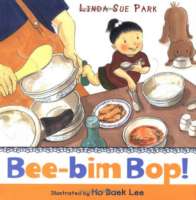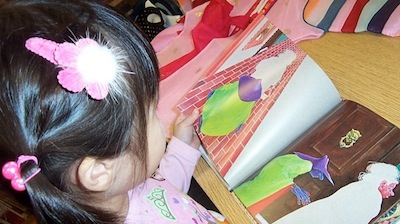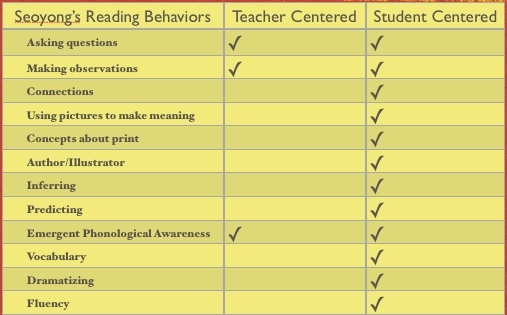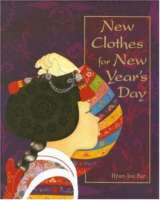“No, I Don’t Want To!” Nurturing Contexts for Sharing Culturally Specific Literature
Angie Zapata
My work as a literacy tutor involved planning literature-based lessons for Seoyoung, an emergent Korean American bilingual learner. During an initial observation in her pre-kindergarten classroom, I watched Seoyoung transform from a thoughtful block architect to a playful Tyrannosaurus Rex and a doting mommy. Amazed at her ease with taking up such a variety of conditional roles from different worlds, I presumed this facility would transfer between her Korean and American lives as well. Instead, Seoyoung compellingly revealed how, in just four years, she had already marked both linguistic and cultural borders between her home and school. In this vignette, I story my learning from Seoyoung and the profound impact her justly founded resistance had on the ways I share culturally specific literature in the classroom.
Seoyoung attended a culturally and linguistically diverse elementary school. Her parents were both international graduate students at the local state university, both fully bilingual/biliterate and very interested in their daughter’s development as a bilingual/biliterate child. To my surprise, classroom observations indicated Seoyoung spoke, read, and wrote almost exclusively in English, despite having access to Korean specific picturebooks, Korean speaking peers and a teacher who took great care to represent a Korean life within her classroom. With her parents, however, Seoyoung responded primarily in Korean and would self select Korean literature from her home library. This symbolic border between her school and home lives and languages emerged as a palpable line drawn between Seoyoung and me, a real line with real consequences for her reading behaviors.
Reading to Seoyoung
My presumption that I had a right to access Seoyoung’s home life, language, and literacies proved inappropriate during our first few sessions. These sessions included shared reading (where both the teacher and the student have access to and read aloud the print) of a Korean specific song or rhyme and a teacher read aloud of a Korean specific picturebook. We concluded with a language experience activity, an approach to reading instruction based on the personal experiences of the learner written down by a teacher and read together with the learner.
The first sessions unintentionally took on a teacher-centered format. I introduced the song, I chose the book to read, I planned the inquiry, I forced the language experience and I made up the joke that concluded our time together. The unidirectional nature of the impermeable curriculum (Dyson, 1993) I had developed–setting up school knowledge as insulated and disconnected from children’s emergent meaning-making, language and literacy resources– elicited resistance from Seoyoung rather than serving as a means to call on her cultural and linguistic resources. Moreover, in choosing texts that immediately located talk around her Korean heritage, Seoyoung retreated. Clearly, my culturally specific approach and my text selection had failed to also tap into her interests and life as four-year-old girl. The negative implications of such a framework were most evident in her reading behaviors.
“No, I Don’t Want To”
 During our second meeting, Seoyoung and I reflected on the previous session’s reading of The Grey Lady and the Strawberry Snatcher by Molly Bang. The questions, connections, observations, and talk around rich vocabulary had proven memorable for us both. In my mind we were through with the book, but for Seoyoung, we were not. I had planned to read aloud Bee-bim Bop! by Linda Sue Park (2008), a picture rich, rhythmic tale of a mother and daughter preparing bee-bim bop, a tradition Korean dish. The colorful illustrations and culturally relevant depiction of a Korean family made this an obvious choice to me. The rhyme and opportunity for dramatization also contributed to this choice. What I did not account for was her rejection to my invitation.
During our second meeting, Seoyoung and I reflected on the previous session’s reading of The Grey Lady and the Strawberry Snatcher by Molly Bang. The questions, connections, observations, and talk around rich vocabulary had proven memorable for us both. In my mind we were through with the book, but for Seoyoung, we were not. I had planned to read aloud Bee-bim Bop! by Linda Sue Park (2008), a picture rich, rhythmic tale of a mother and daughter preparing bee-bim bop, a tradition Korean dish. The colorful illustrations and culturally relevant depiction of a Korean family made this an obvious choice to me. The rhyme and opportunity for dramatization also contributed to this choice. What I did not account for was her rejection to my invitation.
Reading to Seoyoung: Seoyoung declines an invitation to read Bee-bim Bop! by Linda Sue Park.
Despite having anchored my instruction in affirming her heritage though literacy experiences, when presented with opportunities to draw from her Korean life, Seoyoung chose to assert the binary she had so cleverly created between her Korean and American worlds. In the video, Seoyoung clearly states, “No, I don’t want to!” and calls for the “other book”. A transcript of the entire read aloud sampled in this video would reveal the following reading behaviors from Seoyoung: two observations, one question, and attention to a few of the letters beginning the sentences in Bee-bim Bop! Her resistance and the teacher-centered nature of the instruction limited her reading behaviors rather than inviting her to take up the meaning making she engaged in daily both at school and at home. As seen in the video, when asked if she had ever eaten bee-bim bop, an attempt to invite a connection to the text, Seoyoung initially nods yes and then later shakes her head no, declining any claim of this cultural knowledge. Her facial expressions and gestures clearly indicated a lack of interest and motivation to engage with the story and her Korean specific experiences. In forcing us to move through Bee-bim Bop! I was making unwelcome claims on her Korean heritage. Seoyoung held firm to her cultural borders during this lesson, making any talk unidirectional on my part.
Reading with Seoyoung
A shift in the nature of our sessions was needed. In response, our workspace was flooded with new literature, including wordless picture books, Korean specific texts, as well as a few new choices that linked to her personal interests. To begin each session, Seoyoung was invited to choose a text to “retell,” an opportunity for her to recount a familiar text. We would continue with repeated reading of old favorites for the first 15 minutes of our “warm up” reading. One ritual that emerged during warm up time was to retell The Grey Lady and the Strawberry Snatcher by Molly Bang (1996). Of our sessions together, Seoyoung chose to read this text the most.
 Figure 1: Reading from The Grey Lady and the Strawberry Snatcher by Molly Bang.
Figure 1: Reading from The Grey Lady and the Strawberry Snatcher by Molly Bang.
And again, and again, and again, AND again….
The color rich illustrations of The Grey Lady and the Strawberry Snatcher are fanciful and evocative, appealing to Seoyoung’s sense of the imagined. The endless possibility of story and discovery made it easy for us to step into this fantastical world time and time again. The idea of a blue imp attempting to “snatch” the strawberries from the Grey Lady tickled us both. Even in our fifth read of the story during warm up reading, Seoyoung found plenty to notice and retell.
Reading With Seoyoung: Retelling The Grey Lady and the Strawberry Snatcher by Molly Bang.
In this clip, we see a different side of Seoyoung as a reader. Without a teacher imposing a call for culture in her retelling, Seoyoung was able to engage with the book on her own terms (See Figure 2). For instance, across this reading Seoyoung frequently posed some variation of the question, “Where is the Strawberry Snatcher?” By doing so, she not only guides herself through the book, noticing the Strawberry Snatcher, “again, and again, and again,” but also invites her listener, me, to share in the experience. Seoyoung also more readily took up new vocabulary during these readings, easily integrating “snatcher” and “tiptoe” within her retellings, integral terms to the plot introduced during previous readings. The repeated retelling also contributed to the fluency of her storytelling, as demonstrated in her melodic description of “the hat” that is pulled down and the shift in pace as she comes to the end of the book.

Figure 2: An index of Seoyoung’s reading behaviors
The recurring experience of sharing in the same imagined world became a bridge between Seoyoung and me. My think alouds informed her reading and her reading informed my thinking, creating a new reading each time. The exchange and interplay of our transaction with the text elicited richer reading behaviors from Seoyoung and made for a more permeable curriculum. The bidirectional exchange also supported a bridge to Seoyoung’s resources as a bilingual/bicultural reader.
Seoyoung Takes the Lead
After every warm up reading, I strategically placed a new read aloud on the table. The novelty of a new story to enjoy was very attractive and I could count on Seoyoung to select this book for me to read aloud. We would take our time during the interactive read aloud, building upon the rich meaning making she exhibited and exploring new terms that emerged from the text.
 Midway through our sessions, Seoyoung selected New Clothes for New Year’s Day by Hyun-Joo Bae (2007) for me to read aloud. The simple text and uniquely composed illustrations captured the excitement of dressing for the New Year. In keeping with Korean tradition, the young girl in the story receives new clothes to welcome the New Year. The oversized portraits of some of the pages depicted familiar scenes of grappling with clothing, making it easy for any young reader to step into the story world of dressing for the New Year.
Midway through our sessions, Seoyoung selected New Clothes for New Year’s Day by Hyun-Joo Bae (2007) for me to read aloud. The simple text and uniquely composed illustrations captured the excitement of dressing for the New Year. In keeping with Korean tradition, the young girl in the story receives new clothes to welcome the New Year. The oversized portraits of some of the pages depicted familiar scenes of grappling with clothing, making it easy for any young reader to step into the story world of dressing for the New Year.
After reading aloud the piece once, I read it aloud again, inviting Seoyoung to dramatize the story using the traditional Korean dress laid out on the table. The opportunity to dress as a Korean princess immediately appealed to Seoyoung. I read aloud and watched as Seoyoung tied on the oversized silk skirt and carefully slipped each arm into the rainbow-colored sleeves of the jacket, just like the protagonist in the story. Two pages of informational text at the end of the story explained each item of clothing, its significance, and the role of New Year’s Day in Korean culture. We learned about the juweoni, the small silk pouch that would hold any money grandparents or family members might give her on New Year’s Day. Photographs documented this dramatization and using language experience methods, Seoyoung storied her own version, leaning heavily on the simple pattern and phrases of Bae’s original script.
To my delight, Seoyoung returned to our next session with her own Korean dress from home, very much like that of the girl in the story. She recounted wearing this costume for her grandparents and the special tradition of bowing to honor them. Building upon this experience, Seoyoung dramatized the story once again, but this time with her own dress from home. The text generated and the photographs taken from both dramatizations were compiled into a book for Seoyoung to take home and to share with her family. By the end of the year, Seoyoung could independently read her book as she had read it so many times.
New Clothes For A New Year: A Retelling By Seoyoung.
Learning from Seoyoung
With culturally specific literature becoming more prevalent in schools (Fox and Short, 2003), lessons learned from Seoyoung call on teachers, like myself, to more carefully consider the ways in which this body of literature enters classroom. Though well intentioned, my own assumptions and presumption of the purposes and possibilities of literature oriented to a specific heritage, limited Seoyoung’s literacy learning. Tapping into the lives and interests of bilingual children requires more than flooding the room with culturally specific literature, more than reading them aloud, and more than invitations to students to draw from their funds of knowledge (Gonzalez, Moll, Floyd-Tenery, Rendon, Gonzales, Armanti, 1993), or heritage resources. Even with the best of intentions, a read aloud of culturally specific literature can potentially feel artificial to some bilingual students and invite resistance. Such contexts can both widen and deepen the boundaries bilingual students navigate between their home and school lives. Students, even as young as Seoyoung, may even choose to reject a safe classroom space to claim heritage experiences.
Seoyoung teaches us that before sharing culturally specific texts, teachers and students must develop what Gonzalez, Moll et al describe as confianza, or mutual trust, “which is re-established or confirmed with each exchange and leads to the development of long-term relationships” (p. 3). The relationship of mutual respect and trust that is built over time is fertile ground for growing literacy practices that draw from students’ cultural and linguistic resources. Readings of culturally specific literature rooted in student and teacher confianza cultivates ways of knowing and being that nurture identities as bicultural and biliterate learners. For Seoyoung and me, choice and the ritual of talking over a good book was our bridge to confianza. The repeated practice of losing ourselves in story and laughing over a silly joke created a space for Seoyoung to explore an existence in the borderlands between her Korean and American life with an outsider.
Seoyoung also reminds us that teacher-directed instruction is not conducive to the sharing of culturally specific literature. She shows us that a bilingual student’s motivation and interest in literacy learning must be nested in curriculum that is bidirectional and considerate of the complexity of her cultural and linguistic repertoires. My willingness to relinquish control over the nature and content of our reading and selecting literature that simultaneously recognized the hybridity she lives helped us both experience more productive and authentic literacy learning without “othering” her as Korean. What appear to be very elementary findings have greater implications for how teachers and families begin to think about sharing culturally specific literature.
References
Bae, H. (2007). New clothes for New Year’s Day. Kane/Miller.
Bang, M. (1996). The Gray Lady and the Strawberry Snatcher. New York: Aladdin.
Bishop, R. S. (1992). Multicultural literature for children: Toward a clarification of the concept. In A.H. Dyson and C. Genishi (Eds), The need for story: Cultural diversity in classroom and community (pp. 57-71). Urbana, IL: National Council of the Teachers of English.
Dyson, A. (1993). Negotiating a permeable curriculum: On literacy, diversity, and the interplay of children’s and teacher’s worlds. Concept Paper No. 9. Urbana: National Council of Teachers of English.
Fox, D. & Short, K. (Eds) (2003). Stories matter: The complexity of cultural authenticity in children’s literature. Urbana, IL: National Council of Teachers of English.
Gonzalez, N., Moll, L.C., Floyd-Tenery, M., Rivera, A., Rendon, P., Gonzales, R., & Amanti, C. (1993). Teacher research on funds of knowledge: Learning from households. Washington D.C.: Report to the National Center for Research on Cultural Diversity and Second Language Learning.
Park, L. S. (2008). Bee-bim bop! New York: Sandpiper.
Angie Zapata is currently a doctoral candidate in the Language and Literacy program at the University of Texas at Austin.
WOW Stories, Volume IV, Issue 6 by Worlds of Words is licensed under a Creative Commons Attribution-NonCommercial-ShareAlike 4.0 International License.
Based on a work at https://wowlit.org/on-line-publications/stories/storiesiv6/.

I am looking at how scholars have used fiction literature to help illustrate organizational culture.
For example Carroll’s “Alice’s Adventures In Wonderland” as a means to begin to comprehend and unravel many of the crazy-making phenomenon in organizations.
This new interpretation of a work of literature then allow us to explore the idea using this common framework. (McCabe, 2016). ‘Curiouser and curiouser!’ Organization as Culture Performance. Communication Monographs 50, 126-147. doi:10.1177/0018726715618453
Are you aware of any other instances which scholars have used “fiction to analyze empirical material”?
My search continues and I welcome any knowledge you may have of such instances where art/ creative writing has complimented an unintended subject such as this.
Thank you.
Dear Rachelle,
I am really interested in your work, since my researches include literature, intercultural communication and corporates…
I would like to know something more about your works…and maybe we can share some ideas…
Looking forward to hearing from you,
Sveva
I am homeschooling my twin 12-year-olds this year due to the pandemic, and I want to make sure that they are learning about other cultures and ideas. it is good to know that literature is a great way for them to understand unfamiliar cultural settings by getting to know the characters. Plus, reading fiction is something my kids love to do, so that will get them excited about studying different cultures.